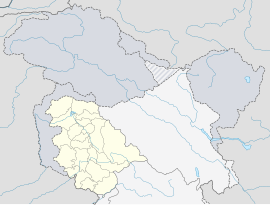Manda, Jammu
Manda is a village and an archaeological site in Jammu. Jammu is in the Indian union territory of Jammu and Kashmir. It was excavated by Archaeological Survey of India during 1976-77. The survey was done by J. P. Joshi. The site contains the ruins of an ancient Indus Valley Civilization.[4]
| Location | Manda, Jammu and Kashmir, India |
|---|---|
| Region | India |
| Coordinates | 32°56′00″N 74°48′00″E / 32.93333°N 74.80000°E |
| Type | Town |
| Part of | Indus Valley Civilisation, Mauryan Empire and Kushan Empire |
| History | |
| Founded | 400BC [1][2] |
| Abandoned | 300A.D [2] |
| Periods | 2350-1750 BC (Indus Valley Civilisation)
(Mauryan Empire)[2] 78-200 C.E (Kushan Empire)[3] |
| Site notes | |
| Excavation dates | 1976-77 |
| Archaeologists | J. P. Joshi |
| Condition | Abandoned |
Excavation
changeThe excavation found 9.20 meters deep of ruins. These consists of items found in 3 different periods of time. The first period contain two sub periods. The second period has early historical pottery. They are from North India. These pottery are similar to the those discovered elsewhere in North India. The third period consists of antiquities from the Kushan period. There are also house walls and a 3 meters wide street found in the ruins.[5] The site seems to have been deserted after that.[4]
Historical significance
changeManda is on the right river bank of Chenab River. The river is at the foot of Pir Panjal mountain range. Manda is 28 km northwest of Jammu. It was thought to be the northernmost limit of the Harappan Civilisation.[5] It is also considered the northmost site of Indus Valley Civilisation.[6][7][8][9][10]
Manda is likely a town that is set up by people of the Indus Valley Civilisation. They likely use it to do logging to get wood from Himalayan Sub mountains. They use the river near the town to send the wood to other towns of the Indus Valley Civilization.[11]
Artefacts
changeThere are several artefacts found in the site. They include redware from the Pre Harappan era. These redware are terracotta jar, plates, racks for plates and others. These made up of 15% to 25% of total artefacts found.[4]
Important artefacts found are broken fragments of pots having the writing system of Harappan people craved into them. There is also one unfinished seal of the Harappan government found in the ruins.[4]
Limitations of excavation
changeThe dig is done on a small, restricted scale. There are no specific structures that could be exposed. One exception is a collapsed rubble wall-like structure.[4]
Related pages
changeReferences
change- ↑ Kumar, Sudershan (2012). "Akhnoor and Indus Valley Civilization". Daily Excelsior. Archived from the original on 2019-10-08. Retrieved 2020-11-08.
- ↑ 2.0 2.1 2.2 KUSHANA SETTLEMENTS AND THEI R MATERIAL CULTURE (PDF). p. 162. Archived (PDF) from the original on 2018-04-15. Retrieved 2020-11-08.
- ↑ Higham, Charles (2014-05-14). Encyclopedia of Ancient Asian Civilizations. Infobase Publishing. p. 212. ISBN 9781438109961. Archived from the original on 2020-11-08. Retrieved 2020-11-08.
- ↑ 4.0 4.1 4.2 4.3 4.4 Indian Archaeology 1976-77, A Review. Archeologival Survey of India, New Delhi.1980. Page 19-21. ASI Archived 8 May 2012 at the Wayback Machine
- ↑ 5.0 5.1 "Archaeological Survey of India". Archived from the original on 2 April 2015. Retrieved 22 June 2012.
- ↑ Kumar, Sudershan (2012). "Akhnoor and Indus Valley Civilization". Daily Excelsior. Archived from the original on 2019-10-08. Retrieved 2020-11-08.
- ↑ Higham, Charles (2014-05-14). Encyclopedia of Ancient Asian Civilizations. Infobase Publishing. p. 212. ISBN 9781438109961. Archived from the original on 2020-11-08. Retrieved 2020-11-08.
- ↑ Shinde, Vasant (Feb 1, 2016). "Harappan Civilization: Current Perspective and its Contribution – By Dr. Vasant Shinde". Origin and Extent. Archived from the original on August 5, 2020. Retrieved November 8, 2020.
- ↑ Roy, T.N (1984). The Concept, Provenance and Chronology of Painted Grey Ware. Vol. 34. Istituto Italiano per l'Africa e l'Oriente (IsIAO). pp. 127–137.
- ↑ Pokharia, Anil K,Jeewan Singh Kharakwal,Alka Srivastava. Archaeobotanical evidence of millets in the Indian subcontinent with some observations on their role in the Indus civilization. Journal of Archaeological Science 42 (2014). p. 442-455. Archived from the original on 2020-11-08. Retrieved 2020-11-08.
{{cite book}}: CS1 maint: multiple names: authors list (link) - ↑ McIntosh, Jane.(2008) The Ancient Indus Valley, New Perspectives. ABC-CLIO.Page 209,412
